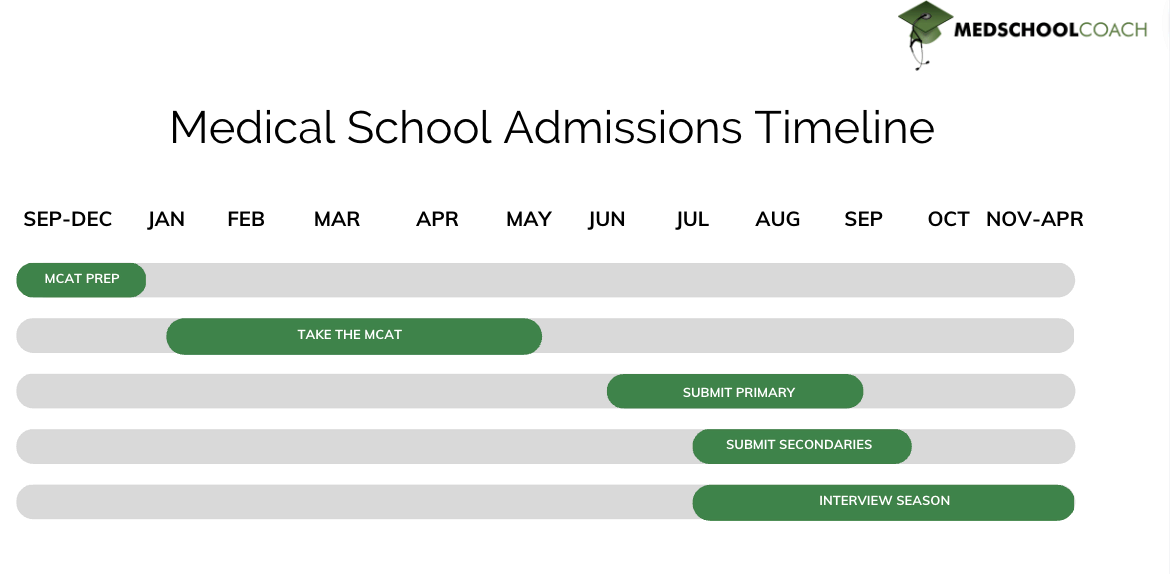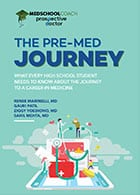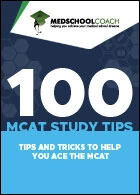
Table of Contents
The admissions process for medical schools takes around a year and is one of the first major milestones of a medical career. Below, I walk you through the steps with tips I’ve learned from nearly two decades of helping students succeed in this journey.
Here’s a quick overview and timeline of what you need to do to successfully apply to medical school:
- Work with your pre-med advisor as early during undergrad as possible to ensure you have all the prerequisites, extracurriculars, and research experience you need.
- Take the MCAT no later than the first week of May of the year you’re applying.
- Craft a memorable personal statement with plenty of time to edit and rewrite it.
- Collect letters of recommendation.
- Decide where you want to apply.
- Complete and submit your primary application(s) by early June.
- Wait 1-6 weeks for verification, at which point schools moving you forward in the process will send you secondary applications.
- Complete your secondaries and submit by mid-July. Plan your responses in advance.
- Interview at each school that requests it. Interviews begin in the fall and take place between September and March.
- Await acceptance letters after your interview, which may arrive from a few weeks after your interview to the end of their interview cycle in March.

When should you apply to medical school? Aspiring medical students used to often apply in the spring/summer of their junior year. However, gap years have become very common — and, in some cases, expected — so you may apply to medical school during the spring of your senior year or a couple of years after you’ve graduated.
With an acceptance rate of 44.6% of applicants in 2024 (up from ~41% in 2023), it will take significant preparation and thoughtful work to stand out from the crowd and secure an acceptance. There are slightly fewer people applying for medical school each year than during the height of COVID, but that doesn’t significantly reduce the difficulty of the application process as a whole.
Let’s take a look at how it works, from start to finish.
Step 1: Prerequisites, Extracurriculars, and Research
Starting as early as during high school, you need to prepare for several requirements on medical school applications. (I briefly cover each below, but I’ve also written in detail about each of these factors at the linked articles.)
Prerequisites: Your pre-health advisor can help you plan coursework around what medical schools require for enrollment. Various medical programs have slightly different prerequisites, so working with your advisor is vital to ensuring you don’t miss anything important.
If you’re late to the game (e.g., you decided in your sophomore year to pursue a medical career), you may need to consider a post-bacc to cover all of your prereqs.
Extracurriculars: Documenting your extracurricular activities is one of the most significant parts of your primary application. I like to think of these in 5 basic categories, each with recommended minimum hours:
- Shadowing (30 hours)
- Research (not necessary for all programs/students)
- Leadership (100 hours)
- Volunteering (150 hours)
- Clinical experience (150 hours)
Remember, these are just minimums — you need to get significantly more to be truly competitive.
Research experience: I mention this separately because my recommendations are very different depending on your individual situation:
- If you plan to apply to medical programs with a strong primary care focus, you may not need research hours.
- If you plan to apply to prestigious, research-focused medical colleges, try to get 400+ hours of research experience before applying.
- If you plan to pursue an MD/PhD, you need at least 1,500 hours of research experience.
Step 2: Take the MCAT
The MCAT (Medical College Admission Test) is a standardized exam that allows students to demonstrate their scientific knowledge necessary to excel in medical school. It is a full-day exam broken into 4 sections.
Prepare for the MCAT for at least 2 months prior to taking the test, prioritizing high-yield topics. Schedule your test date with enough time to get your scores back in early June (generally, this means taking the MCAT by the third week of May at the latest).
You need a competitive score to get accepted to most U.S. medical schools. Here’s what is generally competitive based on recent MCAT score reporting:
- For MD schools: at least 511
- For DO schools: at least 504
- For Ivy League medical programs: at least 515
If your score is not competitive for the medical schools where you want to apply, consider retaking the MCAT and delaying your application for a year. This might be the right call if your score is significantly under the competitive scores above, but don’t wait a whole year just for a point or two.
Read Next: How to Study for the MCAT: Study Tips from 99th-Percentile Tutors
Step 3: Write Your Personal Statement
Your personal statement (also called a “personal comments essay”) should be a story-driven snippet of a significant experience on your journey to becoming a doctor. Give yourself plenty of time (at least 3-4 weeks) between writing your first draft and editing the final version that you’ll include in your primary application.
Read these examples of real personal statements from students who were successfully accepted to medical school.
Step 4: Get Letters of Recommendation
Letters of recommendation (AKA letters of evaluation) allow admissions committees to understand the impression you’ve made on faculty during undergrad. You’ll generally need 2 LoRs from science faculty members and one from a non-STEM professor, but each program has slightly different requirements.
Review the LoR requirements for MD schools and DO schools.
A few tips and things to be aware of:
- While you can submit more, I recommend submitting no more than 4 letters of recommendation per program (unless the committee requests more).
- When applying to DO schools, do your best to include a letter from a DO physician.
- You can use individual letters, committee letters (with quotes from numerous evaluators in one letter), and/or a committee letter packet (a letter from a pre-medical committee or pre-health advisor with an attached supporting set of individual LoRs).
Step 5: Decide Where to Apply
Determining where to apply to medical school can be complicated, as the specifics of your unique ambitions, scores, transcript, and experiences will all play a role. As a general rule, plan to apply to between 15-30 schools (although there’s technically no limit to how many places where you can apply).
Your goal should be to apply to schools that both align with your personal preferences and experiences and where you are likely to be accepted.
Use our handy tool to determine your Med School Competitiveness (MSC) score. You can also use resources such as MSAR and MedSchoolExplorer to compare schools based on several factors, from location to tuition to the average MCAT score of matriculants.
Here are some things to consider:
- Doctors who graduate from MD vs. DO programs get a nearly identical medical education. The three differences to think about are that DO schools include education on OMM (osteopathic manipulative medicine), DO graduates usually pursue primary care specialties, and the average GPA and MCAT scores for DO matriculants tend to be lower than for MD matriculants.
- If you’re interested in serving in the military, there are multiple options for military medicine that allow you to attend medical school for free or at a reduced cost.
- Most medical programs are 4 years long, but 3-year accelerated programs are becoming more popular. Consider an accelerated medical school if you don’t mind a more intense workload and want to save on tuition.
- You’ll need additional application items for MD/PhD or other dual degree programs, including an essay on why you chose this path and a much larger number of research hours.
- The majority of medical colleges in Texas use a separate application system from the rest of the U.S. (TMDSAS), and these programs are far more likely to accept TX residents than out-of-state applicants.
- Some students choose to apply to an early decision program for the chance to secure acceptance early in the cycle at a specific school of medicine they have their heart set on. I almost never recommend this, but if you have an incredibly strong application and are certain that you are interested in only a single medical program, it is an option.
My team has curated several medical school lists to help you build your own:
- 12 of the Best Medical Schools in the U.S.
- The 4 HBCU Medical Programs In the US (and 2 Coming Soon)
- The Easiest 30 U.S. Med Schools to Get Into
- The Best Medical Schools for Non-Traditional Applicants
- Accelerated Medical Schools in the U.S.
- Medical Schools that Accept International Students
- The 6 Best Caribbean Medical Schools
- Medical Schools That Don’t Require the MCAT
Step 6: Submit Your Primary Application(s)
There are 3 primary applications for United States-based medical schools and one for Ontario med schools:
- AMCAS* (opens May 2025): You’ll use the American Medical College Application Service to apply to MD programs (allopathic medicine). The AMCAS application system opens at the beginning of May but doesn’t accept submissions until the end of the month. Check the AAMC Fee Assistance Program page to see if you’re eligible for an application fee waiver.
- AACOMAS (opens May 2025): The AACOM manages this application system for DO programs (osteopathic medicine). It typically opens on similar dates to AMCAS.
- TMDSAS (opens May 2025): Most Texas medical schools use the TX application system, which differs slightly in some key areas. This application opens about two weeks before submissions are allowed.
- OMSAS** (opens July 2025): You must use the Ontario Medical Schools Application System (OMSAS) for most Ontario medical schools.
Your primary applications will require all of what I covered in Steps 1-5, plus your transcripts and various basic and demographic information about you.
*The AAMC (Association of American Medical Colleges) manages the AMCAS system and also develops/administers the MCAT exam.
**As of 2026, Ontario medical schools will accept virtually zero international students, including those who graduate from U.S. universities.
How do you stack up against the competition? Try our Med School Competitiveness tool today to calculate your acceptance odds!
Step 7: Verification
Medical school application verification takes 1-6 weeks to complete after submission. Your primary application goes through this verification process to compare your submitted information to your undergraduate transcripts before submitting it to your chosen schools.
The longer you wait to submit during the cycle, the longer this verification will take. That’s one reason why submitting your primary application as soon as possible is key — the earlier you submit, the earlier your application will be reviewed (while the most interview spots are still available).
Step 8: Submit Your Secondary Applications
Submit all secondaries no later than the end of July. In addition to the essay prompts each school will include, you must ensure your situational judgment test (SJT) results, if required by any of the programs you chose, are submitted to the AAMC or AACOM by this time (Casper and/or AAMC PREview results being the most common).
DO and MD programs don’t typically review applications as soon as verification is complete, but they send over secondary applications to students who pass their minimum requirements. Check out this prompts database to start writing answers to common secondary questions right after submitting your primary application.
During this evaluation of your application materials, medical schools will drop you into one of 3 categories:
- Interview: You’ll get an interview invitation to meet with the medical school admissions committee, typically between September and March.
- On hold: In some cases, a school may not be immediately ready to move forward, but not ready to reject your application. “On hold” is different from “waitlisted.”
- Rejection: When a school decides you aren’t the right fit for their program, you’ll get a message telling you you’ve been rejected.
Step 9: Interviews
Between September and March, you’ll attend medical school interviews with schools that are interested in you as a candidate.
Depending on the school, interviews may be in the MMI format (short, one-on-one interactions with several committee members) or a traditional panel interview format (one longer interaction with a few admissions committee members).
Interviews may be in-person or virtual. Medical schools switched to virtual interviews during the COVID pandemic, and while a few have gone back to in-person or hybrid formats, the vast majority still conduct interviews virtually. Preparing for these interviews takes quite a bit of time because they’re such an important part of the process. When getting ready, review common interview questions (including what you’re more likely to be asked during an MMI) and practice with friends and a mentor to become comfortable.
Step 10: Admissions Decisions
Depending on the school, acceptance decisions may be made at any point between September and March of your admissions cycle. Based on my experience as an admissions advisor, most accepted students get 2-3 acceptance letters, offering them a few options to choose from.
Even if you received just one, you should be proud of your achievement! The U.S. medical school admissions process is uber-competitive, and getting to even one school is a remarkable accomplishment.
Some schools send acceptance letters within a few weeks of your interview day (rolling admissions). Others wait until March to make final decisions on accepted applicants, after all candidates have been interviewed. Even if you interview in September, schools in the latter category won’t get back to you for several months, rather than sending out feedback on a rolling basis.
How long does it take schools to look at applications? Medical schools evaluate applications in mid-to-late July at the earliest. Some schools may have extended timelines and might not even look at your application until August. Some schools want to get a batch of applications before they start looking at them.
Considerations for Reapplicants
If you’re reapplying to medical school after a rejection, keep in mind that you need to show a significant improvement in your eligibility and readiness for medical school since your first application. This may be in the form of higher scores on the MCAT, a new-and-improved GPA from a Special Master’s Program, more extensive extracurriculars, or a combination of these and other factors.
If you weren’t already, you’re unlikely to be accepted the second time without a major overhaul to your last application.
Considerations for Non-Traditional Applicants
Non-traditional applicants may face unique challenges compared to students with science degrees applying within a few years of undergrad. However, if you’re not a traditional applicant, you can highlight your differences as strengths, which may help you stand out.
Generally, non-traditional applicants are those who:
- Are over 26 years old
- Pursued another career before medicine
- Majored in something other than science
- Have a spouse and/or children
- Have taken several gap years, and not just to prepare for medical school (e.g., not just a year off for a post-baccalaureate)
If one or more of the above applies to you, read our guide to applying to medical school as a non-traditional applicant for firsthand tips from a successful physician who began her journey in a very untraditional way.
FAQs
Waiting until the application deadline gets close will significantly disadvantage your application. It is always better to apply early to stand out to admissions committees. Late applications are far less likely to be successful.
An overall GPA of 3.6 and a BCPM GPA (sometimes called “science GPA”) of 3.7 are competitive enough for most applicants and programs. These averages are generally higher for MD/PhD applicants and Ivy League schools, and slightly lower for DO programs.
An MCAT score of 511 is competitive for most programs. DO applicants need at least a 504 to be competitive, and if you apply to the Ivy League, aim for at least a 515 on the MCAT.
Yes, even if you fall below the “competitive” averages, you can get into medical school. However, it will require you appear compelling in other portions of your application, like with an impressive resume of extracurricular activities, an extremely compelling personal statement, or a large number of research hours.
If you’re concerned about not being competitive enough to get accepted, consider waiting for the next application cycle and improving your application by:
- Retaking the MCAT if you think you can increase your score by more than 6 points (MCAT tutoring can help you here; our students improve their scores by about 12 points on average)
- Completing a post-baccalaureate program to improve your GPA and retake important classes for which you got a poor grade
- Logging more clinical experience hours in your full-time day job
- Investing in medical school application consulting to more than double your chances of acceptance
For most students, applying to medical school costs between $2,000 and $3,000. This includes primary application fees (the initial fee and fees for additional school designations), secondary application fees per school, and interview travel costs.
No, this is absolutely a myth! If you aren’t posting offensive or inappropriate content, using social media to your advantage may help you become a desirable applicant. Go the extra mile and use social media strategically to improve your chances of acceptance.
No, you don’t need to contact AMCAS after submitting your application. Once your application is received, you’ll receive an email with a status update via your application portal. You can also check the status of your application online at any time to track the progress of verification and the application itself.
Bottom Line
If you want to apply to medical school in 2026 and beyond, aim to have your ducks in a row by May. It’s almost a year-long process, so you’ve got to have some patience.
When you start filling out your application, remember that you might not reap the benefits until March of next year. But the payoff of stepping closer to your dream of being a physician makes the wait well worth it!
Want one-on-one support as you prepare your application? 92% of our students successfully get into medical school, twice the national average!

Sahil Mehta MD
Dr. Mehta is the founder of MedSchoolCoach and has guided thousands of successful medical school applicants. He is also a practicing physician in Boston where he specializes in vascular and interventional radiology.










